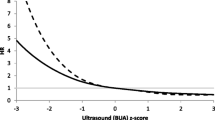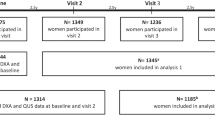Abstract
The performance of quantitative ultrasound (QUS) for the assessment of osteoporotic fracture must be fully defined if it is to be used in the clinical setting. We have examined the precision and reproducibility of two ultrasound instruments in 1,267 institutionalized elderly men and women (mean age 82.1 and 85.9 years, respectively). Measurement of BUA and VOS was reliable, least significant change for BUA being 2.4% and for VOS 0.3% using the CUBA McCue instrument and 2.7% for BUA using the Metra QUS-2. Importantly, age was not found to influence the precision of either parameter. Comparison of the instruments showed the QUS-2 measures BUA higher than the CUBA by 1.9 dB/MHz (±9.55 dB/MHz). Moreover classification of individuals as osteoporotic by machine-derived T-score was different between instruments (κ=0.44 in men and κ=0.62 in women). Fifty-six residents were remeasured by CUBA after 2.2 years; BUA was observed to decrease by 5.2% (±16.5%, p=0.02) without significant change in VOS, suggesting BUA is more useful in longitudinal studies. In conclusion, ultrasound measurements were highly reliable and sensitive to longitudinal change even in the very elderly. However, diagnosis by T-score criteria was instrument specific, and such criteria should be interpreted with caution in the assessment of fracture risk.


Similar content being viewed by others
References
Schott AM, CormierC, Hans D, Favier F, Hausherr E, Dargent-Molina P, Delmas PD, Ribot C, Sebert JL, Breart G, Meunier PJ (1998) How hip and whole-body bone mineral density predict hip fracture in elderly women: the EPIDOS Prospective Study. Osteoporos Int 8(3):247–254
Hui S L, Slemenda CW, Johnston CC Jr (1987) Age and bone mass as predictors of fracture in a prospective study. J Clin Invest 81:1804–1809
Nguyen T, Sambrook P, Kelly P, Jones G, Lord SL, Freund J, Eisman J 1993) Prediction of osteoporotic fractures by postural instability and bone density. BMJ 307:1111–1115
Marshall D, Johnell O, Wedel H (1996) Meta-analysis of how well measures of bone mineral density predict occurrence of osteoporotic fractures. BMJ 312:1254–1259
Hans D, Dargent-Molina P, Schott AM (1996) Ultrasonographic heel measurements to predict hip fracture in elderly women: the EPIDOS Prospective Study. Lancet 348:511–514
Bauer DC, Gluer CC, Cauley JA, Vogt TM, Ensrud KE, Genant HK, Black DM (1997) Broadband ultrasound attenuation predicts fractures strongly and independently of densitometry in older women: a prospective study. Study of Osteoporotic Fractures Research Group. Arch Intern Med 157(6):629–634
Krieg MA, Jacquet AF, Bremgartner M, Cuttelod S, Thiebaud D, Burckhardt P (1999) Effect of supplementation with vitamin D3 and calcium on quantitative ultrasound of bone in elderly institutionalized women: a longitudinal study. Osteoporos Int 9(6):483–488
Gonnelli S, Cepollaro C, Montagnani A, Martini S, Gennari L, Mangeri M, Gennari C (2002) Heel ultrasonography in monitoring alendronate therapy: a four-year longitudinal study. Osteoporos Int 13(5):415–421
Zochling J, Sitoh YY, Lau TC, Cameron ID, Cumming RG, Lord SR, Schwarz J, Trube A, March LM, Sambrook PN (2002) Quantitative ultrasound of the calcaneus and falls risk in the institutionalized elderly: sex differences and relationship to vitamin D status. Osteoporos Int 13(11):882–887
Iki M, Kajita E, Mitamura S, Nishino H, Yamagami T, Nagahama N (1999) Precision of quantitative ultrasound measurement of the heel bone and effects of ambient temperature on the parameters. Osteoporos Int 10(6):462–467
Bland JM, Altman DG (1986) Statistical methods for assessing agreement between two methods of clinical measurement. Lancet 1(8476):307–310
Lin LI (1989) A concordance correlation coefficient to evaluate reproducibility. Biometrics 45(1):255–268
Blake GM, Wahner HW, Fogelman I (1999) Commercial ultrasound instruments. The evaluation of osteoporosis: dual energy x-ray absorptiometry and ultrasound in clinical practice, 2 edn. Martin Dunitz, London
Thuy VT, Chau TT, Cong ND, De DV, Nguyen TV (2003) Assessment of low bone mass in vietnamese: comparison of QUS calcaneal ultrasonometer and data-derived T-scores. J Bone Miner Metab 21(2):114–119
World Health Organization (1994) Assessment of fracture risk and its application to screening for postmenopausal osteoporosis. WHO Technical Report Series, No. 843. World Health Organization, Geneva, pp 1–129
Schott AM, Hans D, Garnero P, Sornay-Rendu E, Delmas PD, Meunier PJ (1995) Age-related changes in os calcis ultrasonic indices: a 2-year prospective study. Osteoporos Int 5(6):478–483
Krieg MA, Thiebaud D, Burckhardt P (1996) Quantitative ultrasound of bone in institutionalized elderly women: a cross-sectional and longitudinal study. Osteoporos Int 6(3):189–195
Warden SJ, Bennell KL, Matthews B, Brown DJ, McMeeken JM, Wark JD, Wark JD (2002) Quantitative ultrasound assessment of acute bone loss following spinal cord injury: a longitudinal pilot study. Osteoporos Int 13(7):586–592
Laugier P, Novikov V, Elmann-Larsen B, Berger G (2000) Quantitative ultrasound imaging of the calcaneus: precision and variations during a 120-day bed rest. Calcif Tissue Int 66:16–21
Falcini F, Bindi G, Simonini G, Stagi S, Galluzzi F, Masi L, Cimaz R (2003) Bone status evaluation with calcaneal ultrasound in children with chronic rheumatic diseases. a one year followup study. J Rheumatol 30:179–184
Daly RM, Rich PA, Klein R, Bass S (1999) Effects of high-impact exercise on ultrasonic and biochemical indices of skeletal status: a prospective study in young male gymnasts. J Bone Miner Res 14(7):1222–1230
Gonnelli S, Cepollaro C, Montagnani A, Martini S, Gennari L, Mangeri M, Gennari C (2002) Heel ultrasonography in monitoring alendronate therapy: a four-year longitudinal study. Osteoporos Int 13(5):415–421
Frost ML, Blake GM, Fogelman I (2001) Changes in QUS and BMD measurements with antiresorptive therapy: a two-year longitudinal study. Calcif Tissue Int 69(3):138–146
Sahota O, San P, Cawte SA, Pearson D, Hosking DJ (2000) A comparison of the longitudinal changes in quantitative ultrasound with dual-energy X-ray absorptiometry: the four-year effects of hormone replacement therapy. Osteoporos Int 11(1):52–58
Gonnelli S, Cepollaro C, Pondrelli C, Martini S, Rossi S, Gennari C (1996) Ultrasound parameters in osteoporotic patients treated with salmon calcitonin: a longitudinal study. Osteoporos Int 6(4):303–307
Author information
Authors and Affiliations
Corresponding author
Rights and permissions
About this article
Cite this article
Zochling, J., Nguyen, T.V., March, L.M. et al. Quantitative ultrasound measurements of bone: measurement error, discordance, and their effects on longitudinal studies. Osteoporos Int 15, 619–624 (2004). https://doi.org/10.1007/s00198-004-1594-5
Received:
Accepted:
Published:
Issue Date:
DOI: https://doi.org/10.1007/s00198-004-1594-5




